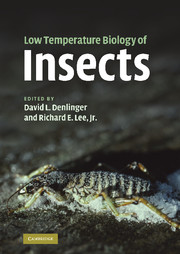Book contents
- Frontmatter
- Contents
- List of contributors
- Preface
- PART I PHYSIOLOGICAL AND MOLECULAR RESPONSES
- PART II ECOLOGICAL AND EVOLUTIONARY RESPONSES
- 8 The macrophysiology of insect cold-hardiness
- 9 Evolutionary physiology of insect thermal adaptation to cold environments
- 10 Insects at not so low temperature: Climate change in the temperate zone and its biotic consequences
- 11 Genetic variability and evolution of cold-tolerance
- 12 Life-history adaptations to polar and alpine environments
- PART III PRACTICAL APPLICATIONS
- Index
- References
10 - Insects at not so low temperature: Climate change in the temperate zone and its biotic consequences
from PART II - ECOLOGICAL AND EVOLUTIONARY RESPONSES
Published online by Cambridge University Press: 04 May 2010
- Frontmatter
- Contents
- List of contributors
- Preface
- PART I PHYSIOLOGICAL AND MOLECULAR RESPONSES
- PART II ECOLOGICAL AND EVOLUTIONARY RESPONSES
- 8 The macrophysiology of insect cold-hardiness
- 9 Evolutionary physiology of insect thermal adaptation to cold environments
- 10 Insects at not so low temperature: Climate change in the temperate zone and its biotic consequences
- 11 Genetic variability and evolution of cold-tolerance
- 12 Life-history adaptations to polar and alpine environments
- PART III PRACTICAL APPLICATIONS
- Index
- References
Summary
Introduction
Herein, we consider insects in the temperate zone where, in central and eastern continental land masses, favorable summers are interspersed with inamicable, often lethal, winters. At latitudes higher than 30°, fitness consists of the ability to exploit the warm season through growth, development and reproduction, the ability to avoid or mitigate the effects of winter cold through dormancy or migration, and the ability to make a timely transition between summer and winter lifestyles. Fitness is then defined by performance integrated through all four seasons, not just by a measure of performance in a single environment characteristic of a single time of year.
Below we discuss the geographical and seasonal patterns in light and temperature in the temperate zone, how climate change is affecting and will affect these patterns, and the actual and potential biotic responses by insects to climate warming. Physiological processes lie at the level of integration between the environment and the gene, and are important in regulating the acquisition, assimilation and allocation of resources, in regulating growth, development and reproduction, and in maintaining homeostasis in variable environments. Environmental change elicits a physiological response, either through non-genetic change within individual animals (homeostasis and phenotypic plasticity) or through genetic change in animal populations (evolution). Mechanism matters. Physiological processes enable animals to maximize survivorship and reproduction, and are primary determinants of fitness in environments that vary in time and space.
- Type
- Chapter
- Information
- Low Temperature Biology of Insects , pp. 242 - 275Publisher: Cambridge University PressPrint publication year: 2010
References
- 18
- Cited by



